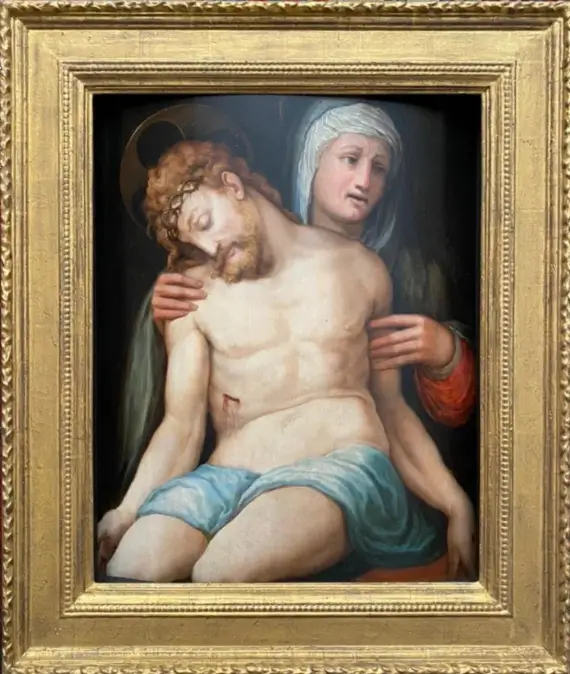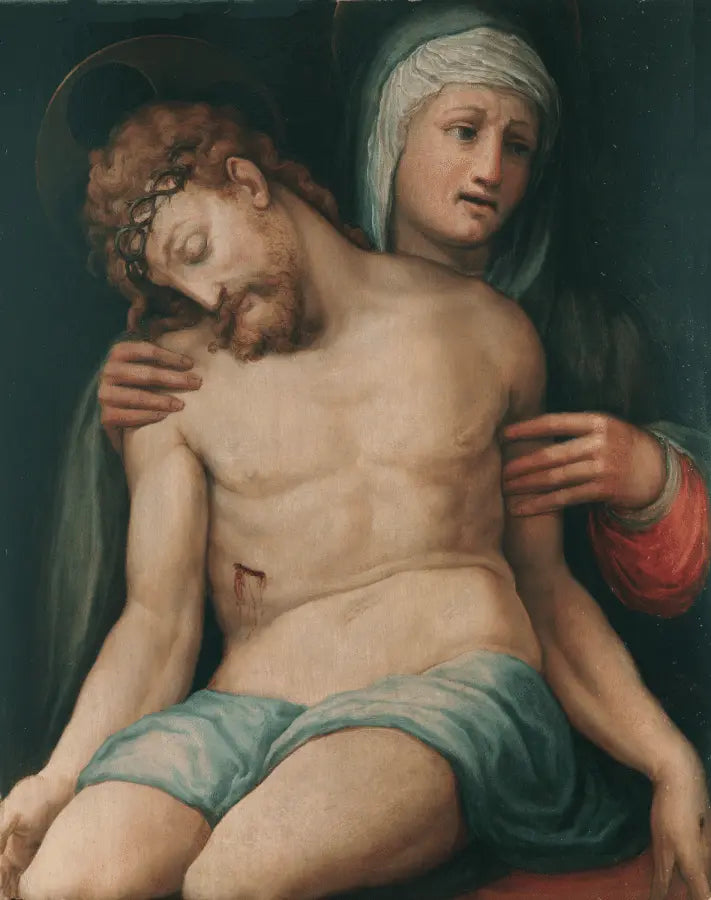

Circle of Ridolfo Ghirlandaio
The Lamentation of Christ
Oil on panel
Image size: 20 ½ x 16 ½ inches (52 x 42 cm)
Handmade contemporary style gilt frame
The lamentation of Christ was one of the most popular scenes depicted in European art from the 11th to the 18th century. Depicting the lamentation or pieta from the Italian word for ‘Pity’ of Christ with Jesus’s mother Mary cradling his body.
Christ is depicted nude, wearing only a blueish loincloth around his waist, a horizontal scar marking his rib cage. His head and torso are held upright, and his eyes are closed, his right arm lays to his side as does his left. Standing behind him, is the Virgin Mary, outfitted in her traditional dress of a robe with a white veil. She stands behind Christ and bends slightly, looking looking away from Christ to something that has caught her attention, her right hand holding his shoulder. Her left-hand carefully holds his arm.
This work is quite unusual with Mary. This stunning work jumps out with its dark background and strong flesh colours.
Ridolfo Ghirlandaio
Ghirlandaio was the son of th eminent painter Domenico Ghirlandaio. Following his father’s death in 1494, when he was just eleven years old, Ridolfo is thought to have continued his training with his uncle Davide, who had taken over the Ghirlandaio workshop. Vasari noted that Ridolfo also studied with Fra Bartolommeo, and indeed the influence of the latter is evident in much of his early work, as is that of Piero di Cosimo and Raphael, with whom Ridolfo was friendly during the latter’s stay in Florence. (Vasari writes that Ridolfo completed the blue robe of the Virgin in Raphael’s painting La Belle Jardinière, today in the Louvre.) Ridolfo soon gained a measure of independence within the Ghirlandaio bottega, and several paintings of the early 1500’s commissioned from Davide would appear to be by his nephew. His earliest documented painting, however, is a Virgin of the Sacred Girdle in the Duomo in Prato, commissioned from both Davide and Ridolfo in 1507 but largely the work of the younger artist and completed in 1509.
As an independent artist, Ridolfo Ghirlandaio enjoyed a long and highly successful career, with a number of significant public commissions in Florence, including the fresco decoration of the Cappella della Signoria in the Palazzo Vecchio, begun in 1514, and two paintings of scenes from the life of Saint Zenobius for the Compagnia di San Zanobi, painted between 1516 and 1517. Ridolfo had a large and busy studio in Florence (where among his pupils was the young Perino del Vaga) and counted among his patrons members of the Medici, Antinori and Ricasoli families, among others. He produced altarpieces and frescoes for such Florentine churches as Santa Maria Novella, Santo Spirito and Santa Maria degli Angeli, as well as altarpieces for several towns outside Florence, and also enjoyed a particular reputation as a portrait painter.



